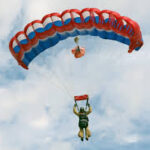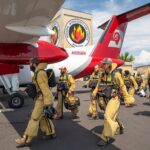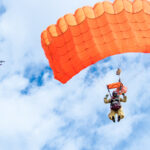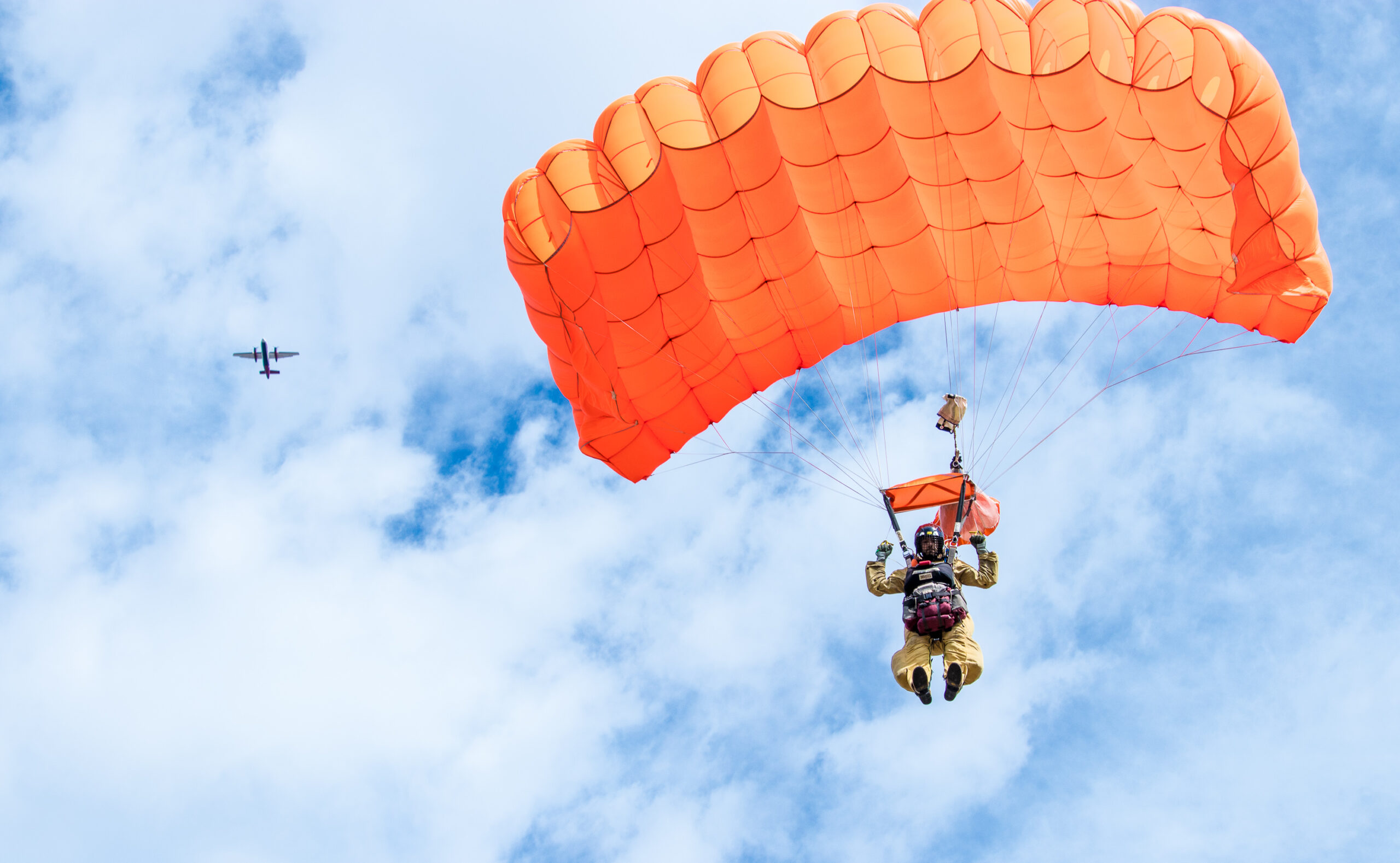
The Boise BLM smokejumpers train to use the Dash 8 plane from Alaska as a jump platform durning an evaluation process in the Lower 48.
By: Jake Miller
Smokejumping is often synonymous with high-adrenaline, precision parachuting into the heart of raging wildfires. The brave individuals who leap out of planes into burning forests are well-known for their courage, but behind every successful mission is a lesser-known yet vital figure: the smokejumper spotter. This role, essential yet rarely discussed, involves coordination, planning, and the experience to make life-or-death decisions from the safety of the aircraft. In this article, we will explore the critical and underappreciated role of the spotter in smokejumping operations, highlighting how these unsung heroes contribute to wildfire containment efforts across the world.
The Role of the Smokejumper Spotter
The spotter’s role is multifaceted, requiring keen judgment, leadership, and an intimate understanding of both the terrain and fire behavior. Spotters are experienced smokejumpers who no longer jump into fires themselves but instead serve as mission leaders in the aircraft, ensuring that the parachuting crew lands in the right location, at the right time, with the least risk possible.
Unlike a typical air crew member who might simply monitor flight instruments or assist the pilot, a smokejumper spotter takes on far greater responsibility. Their task is to ensure that the jumpers are deployed in safe, accessible areas, close enough to the fire to be effective but far enough to avoid landing in hazardous zones like tree canopies, cliffs, or the fire itself. They are, in essence, air traffic controllers for the smokejumper team, directly overseeing the aerial part of the firefighting mission.
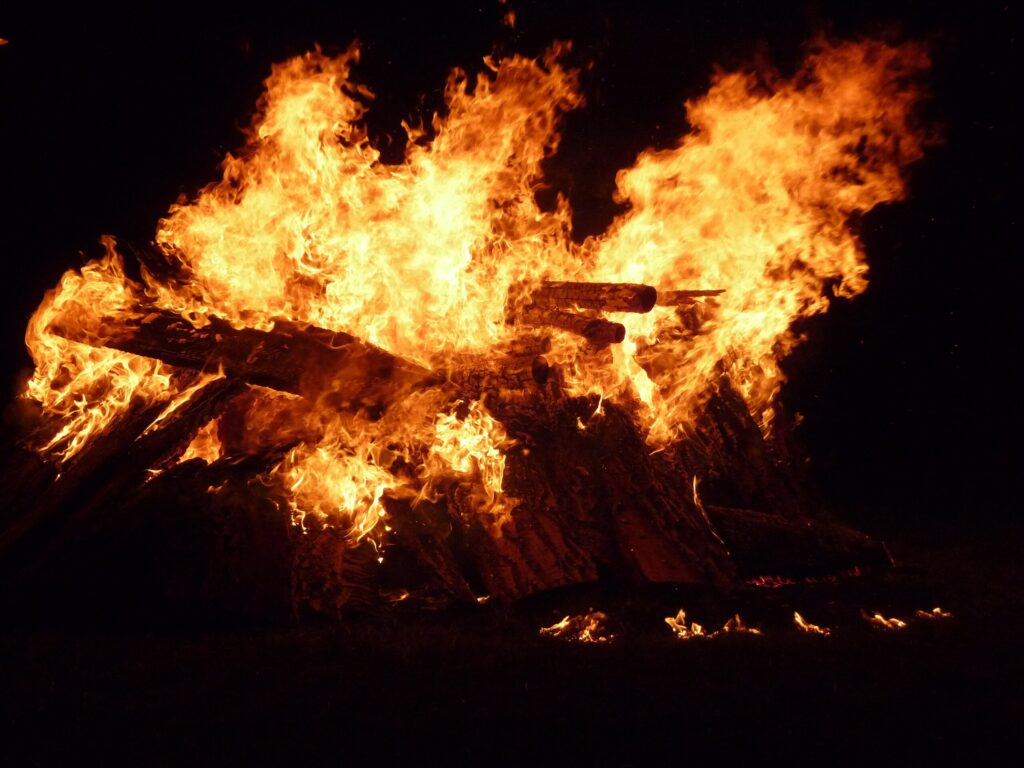
A Day in the Life of a Smokejumper Spotter
A typical day for a smokejumper spotter begins long before the aircraft takes off. The spotter works closely with fire managers, air attack personnel, and ground support teams to assess the fire situation, evaluate terrain, weather conditions, and predict the fire’s behavior. This pre-flight planning is crucial, as it provides the spotter with the necessary information to make informed decisions once airborne.
Once in the air, the spotter’s responsibilities increase exponentially. From the moment the plane approaches the fire, the spotter becomes the eyes and ears of the jumpers. Using maps, GPS systems, and years of experience, they evaluate potential jump zones, taking into account wind direction, fire intensity, and terrain obstacles. They must quickly adjust plans if conditions change, ensuring the jumpers land as safely as possible.
The process is not as simple as pinpointing a location on a map and telling the jumpers to go. It involves constant recalculation, communication with the jumpers, and an eye for tiny details. A small shift in wind speed could push a parachutist off course and into danger. Therefore, the spotter must balance caution with urgency — delaying too long could allow the fire to grow, but rushing the jump could put lives at risk.
Equipment and Tools of the Trade
Smokejumper spotters rely on a range of sophisticated equipment to do their job effectively. GPS systems, aerial maps, and wind speed indicators are all standard tools of the trade, but the spotter’s most valuable tool is often their own experience. Years of firsthand jumping experience provide an understanding of how different parachutes behave in various conditions, what the terrain looks like from both the air and the ground, and how fires develop in different environments.
One of the spotter’s key pieces of equipment is the streamers used to test wind conditions. Streamers are lightweight ribbons dropped from the plane before the jumpers, giving the spotter a real-time visual indicator of how the wind is behaving at different altitudes. Watching how the streamer drifts as it falls helps the spotter judge where and when the jumpers should exit the plane.
The spotter also plays a role in managing the aircraft’s cargo. Along with smokejumpers, planes often carry supplies such as chainsaws, firefighting tools, and food or water for the crew. The spotter must ensure that all cargo is dropped accurately in close proximity to the jumpers, so they can access their tools quickly after landing. This task adds an additional layer of complexity, as the cargo drop must be carefully coordinated to avoid injuring jumpers or losing equipment in inaccessible areas.
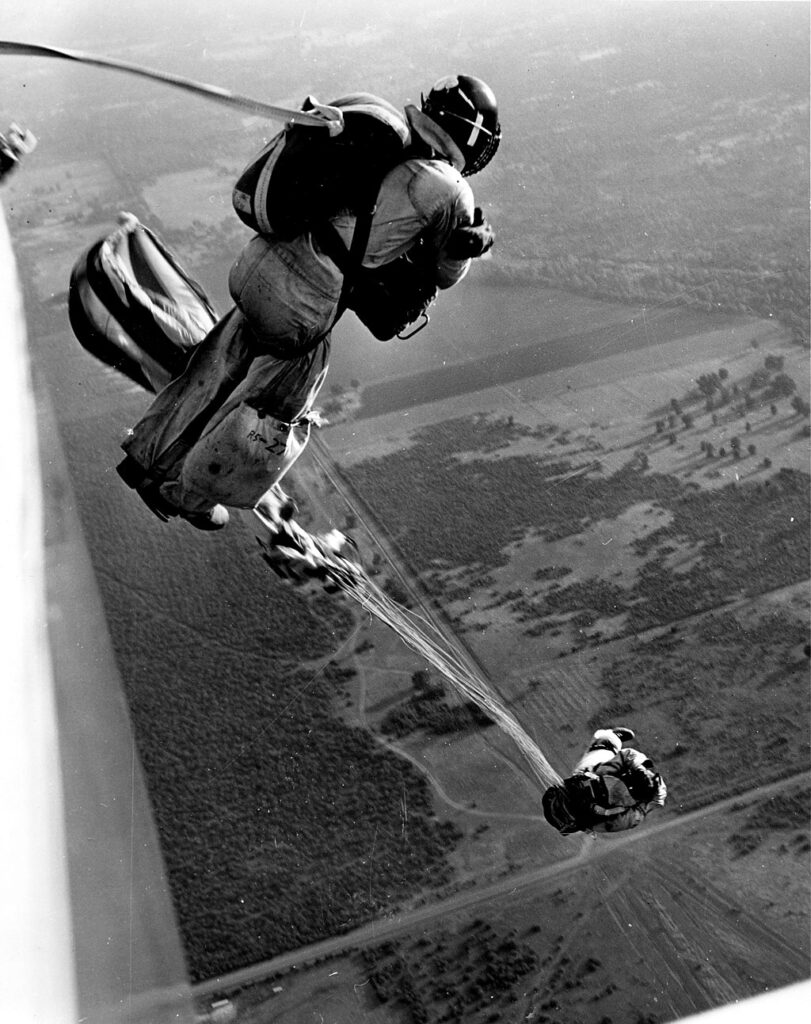
Training and Qualifications
Becoming a smokejumper spotter is no easy feat. Spotters are typically selected from the ranks of veteran smokejumpers who have demonstrated leadership, decision-making skills, and the ability to work under intense pressure. The transition from jumper to spotter is a career milestone, requiring additional training in air operations, fire management, and leadership.
Spotters undergo rigorous training to prepare for the unique challenges of the role. This includes simulated jumps, extensive study of fire behavior, and learning to use advanced navigation tools. They also receive instruction in crew resource management, which focuses on teamwork, communication, and decision-making in high-stakes environments. Spotters must be able to think quickly and remain calm under pressure, as their decisions directly affect the safety of the entire crew.
Beyond technical skills, spotters need to be excellent communicators. They serve as the bridge between the jumpers and the command center, relaying critical information about the fire’s behavior and progress. This requires not only clear communication but also the ability to prioritize information and make decisions based on incomplete or rapidly changing data.
The Spotter-Jumper Relationship: Trust in the Sky
One of the most critical aspects of the spotter’s job is the relationship they have with the jumpers. Trust is paramount in smokejumping, and nowhere is this more evident than in the dynamic between the spotter and the jump crew. Jumpers are literally putting their lives in the hands of the spotter, relying on their judgment and expertise to guide them safely to the ground.
This trust is built over time, often during shared experiences on the fireline. Many spotters have spent years jumping themselves, which gives them a unique perspective on what jumpers are experiencing in the air and on the ground. This shared background fosters mutual respect and understanding, which is crucial when operating in such a high-risk environment.
During a jump, communication between the spotter and jumpers is constant. The spotter provides the jumpers with real-time updates on wind conditions, the location of the fire, and any potential hazards. Jumpers, in turn, must communicate their readiness and position to ensure a smooth and safe operation. This two-way communication is a delicate balancing act, with both parties needing to trust each other’s judgment implicitly.
Challenges and Dangers Faced by Spotters
While spotters may not be jumping into the flames themselves, their role is far from risk-free. Wildfires are unpredictable, and conditions can change rapidly. Wind patterns can shift suddenly, making it difficult to find a safe landing zone. Visibility can be severely limited by smoke, and the heat from the fire can create turbulence that makes flying hazardous.
In addition to the physical dangers, spotters face immense psychological pressure. The decisions they make from the aircraft can have life-or-death consequences for the jumpers on the ground. Every time a smokejumper exits the plane, the spotter must have absolute confidence in their decision. This responsibility can be overwhelming, especially in complex fire scenarios where there may be no perfect solution.
Weather conditions present another major challenge. Strong winds, updrafts, and downdrafts can make it difficult to predict where a parachutist will land, and extreme temperatures can affect the performance of both the aircraft and the parachutes. Spotters must constantly adapt to these changing conditions, sometimes making the difficult decision to abort a jump if the risks become too high.
Case Study: The Crucial Role of Spotters in the 2018 Mendocino Complex Fire
To understand the real-world impact of spotters in smokejumping operations, we can look at the 2018 Mendocino Complex Fire in California, one of the largest wildfires in the state’s history. As the fire grew to over 450,000 acres, smokejumper crews were deployed to assist in containment efforts in remote and rugged areas where ground crews had limited access.
During the operation, spotters played a crucial role in coordinating multiple jumps over difficult terrain. The fire’s unpredictable behavior, combined with strong winds and thick smoke, made it one of the most challenging missions of the season. Spotters had to make split-second decisions about when and where to deploy the jumpers, constantly adjusting their plans as conditions on the ground changed.
In one instance, a team of jumpers was preparing to exit the plane when the spotter noticed a sudden shift in the wind that would have carried them directly into a burning canyon. With only seconds to spare, the spotter called off the jump, redirecting the plane to a safer location. This decision likely saved lives, as the original landing zone became engulfed in flames moments later.
Throughout the Mendocino Complex Fire, spotters coordinated dozens of jumps, ensuring that crews were deployed safely and effectively. Their ability to adapt to rapidly changing conditions and make critical decisions in real time was instrumental in containing the fire and preventing further loss of life.
The Future of Smokejumper Spotting
As wildfires continue to grow in size and intensity due to climate change, the role of the spotter is becoming more important than ever. Advances in technology, such as improved GPS systems, satellite imagery, and drone surveillance, are providing spotters with more tools to help them make informed decisions. However, the human element remains irreplaceable. The experience and intuition that spotters bring to the job cannot be replicated by machines, and their ability to make quick, informed decisions in high-stakes environments will continue to be a cornerstone of wildfire response.
In the coming years, we may see further integration of artificial intelligence and predictive modeling in smokejumper operations, but the role of the spotter will likely remain unchanged at its core: guiding jumpers safely to the ground and ensuring that

